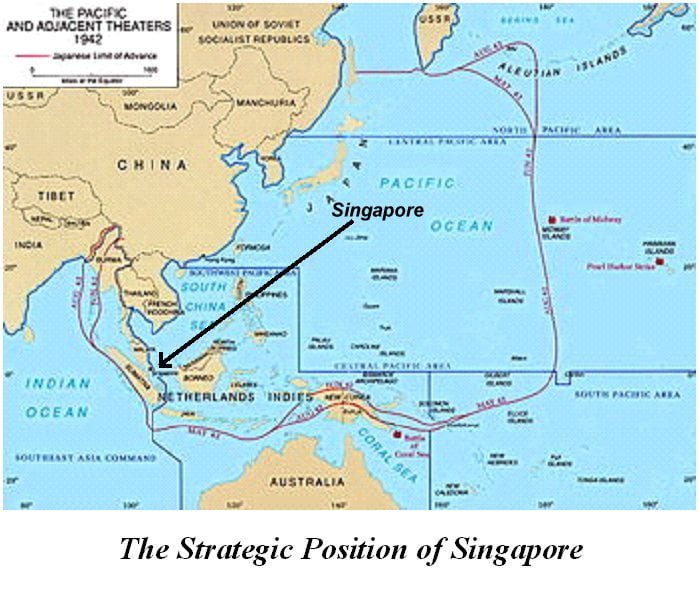
Singapore, which is today an independent city state, but in 1942 was a jewel in the British Empire, and as shown in the map above, was in a strategically important position. This is because the Strait of Malacca is one of the most important shipping lanes in the world. It was, and still is, the main shipping route that links the Indian Ocean to the Pacific one. Through this narrow stretch of water come goods from Asia destined to India and on through the Suez Canal to Europe.
In 1942 we, the British, held it and it was at that time a jewel in our crown.
What happened?
Lieutenant-General Arthur Percival with 85,000 British troops was in command, the problem was they lacked experience and were badly under resourced. However, the General had been instructed by Winston Churchill, the Prime Minister, to defend it to the last man.
Unfortunately, General Percival in making his plans made a big mistake. He decided that the Japanese would not be able to approach Singapore through the jungle. This meant he made the decision that he didn’t need to protect this approach as he expected that the attack would come from elsewhere.
This was a major, major, major error!
The Result!
It gave the Japanese an easy route into Singapore. The really annoying thing about this is that the British had numerical superiority over the Japanese. We had many more soldiers than them, but we didn’t stop them because we were looking the wrong way!
So, what happened? Well, the obvious, the Japanese attacked where we were weakest and very quickly on the 8th of February established a strong beach head on the most vulnerable part of the island.
Now, the next problem was that there was very weak communication between those very few forces on this part of the island and the General.
The result was that the Japanese were able to build up their forces, and to continue in their slow occupation of the island.
Everyone was now beginning to panic, and by the 15th of February over 1,000,000 of the inhabitants of the city had fled into other areas. At the same time the Japanese aircraft were bombing the city, in fact, they were targeting the water supply. This panicked people even further as everyone thought it was going to collapse within a day or so.
The End!
Now at this point the Japanese general was beginning to worry that he would soon run out of his supplies, and he also wanted to stop house to house fighting. For this reason, on the afternoon of the 15th of February he approached the British with a demand for unconditional surrender. Then, to his surprise, General Percival surrendered! The problem was that Percival didn’t really understand the situation and he had all along refused to believe those reporting to him. It was for this reason that he ignored the orders he had been given by Winston Churchill and immediately surrendered Singapore to the Japanese.
The result was horrific!
80,000 British, Indian, Australian and even local troops were taken prisoner, they joined the 50,000 the Japanese had already captured on their way through Malaysia.
At the same time nearly 40,000 Indian soldiers defected, they joined the Indian national army to fight against the British for the Japanese in Burma.
Churchill described this as the worst disaster in British military history. It had a dramatic effect on the confidence of the British people at this important point in the Second World War. Now the loss of Singapore severely damaged the prestige of Britain, some say contributed to the end of our declining empire.
For those people left in Singapore the result was horrific. Just three days after they took over, they began, what is described as the Sook Ching purge, where they killed thousands of citizens who they described as undesirables.
The lesson we should learn from the fall of Singapore is that leadership means the one in charge must:
- Have a plan
- That plan has to survive critical examination by others
- Once in operation it must be able to be modified, should the information change.
- Has to be one that is understood by everyone.
Many generals tell us that most battle plans change after the first shots are fired, it appears this didn’t happen in Singapore.
The lesson
Is that if the general had been prepared to listen to his officers, he would have had time to move his forces to defend the city. He had the men to do this.
It appears that if he had had better information, he would also have known that the Japanese general was running short of supplies and needed a quick surrender. If he had held on, he could have saved Singapore, but of course, he didn’t listen to anybody else but himself, and that must be the lesson that we all learn from the fall of Singapore.
Let’s hope that more leaders listen to their subordinates, they will be surprised at what they can learn from them.
That is the lesson from the fall of Singapore.
Isn’t history fun?
More on this sorry affair:
https://www.cwgc.org/our-work/blog/the-battle-of-singapore-80-years-on/
https://navyhistory.org.au/the-naval-evacuation-of-singapore-february-1942/

